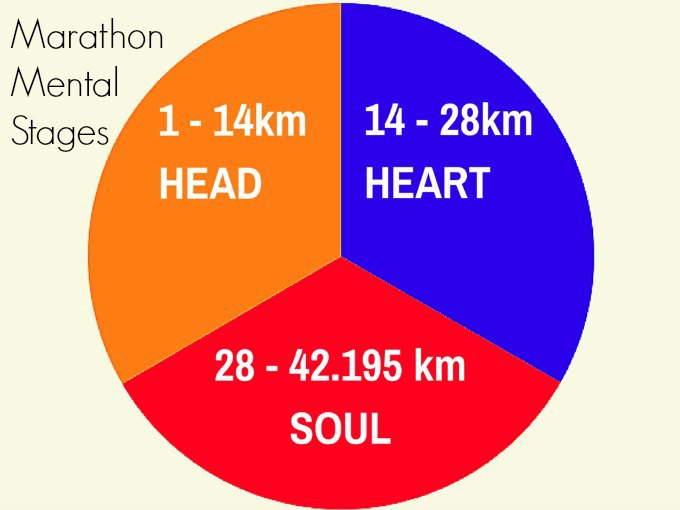Perhaps the alternative title of this post should be ‘How I trained for a marathon’. I’m the first to admit I’m hardly the perfect example of what excellence looks like. I only did three runs a week when many other people do four, or even five. However, I got there in the end. A few people have come up to me over the past few days to ask me how I did it, and I thought I’d write down how I prepared for the big day. Preparation is critical.

1) Be aware of what a major part it will play in your life
You will have approximately sixteen weeks that will be dominated by timetables. One day a week will eventually need to be given over the ‘long run’ – and while a long run won’t take the whole day, it will take up a significant chunk of it, and the rest might be taken up by resting. Tiredness will set in. Evening social engagements (might) become less appealing to attend. Even when you’re not running your thoughts might be consumed by the next run, or the one you just had, ‘post-mortem-ing’ it. It’s a big committment and requires a healthy amount of respect.
2) Get the perfect running bra
I’m speaking from experience here. Earlier this year I bought off the shelf – without trying it on – the same bra (a later version of it, anyway) as the best exercise one I had. However, after a couple of long runs, I was in a lot of pain. The underwire was cutting into my breast tissue. I’d always assumed that having underwired bras would be essential for me because I am fairly generously sized (D cup). Then I remembered borrowing Zoey‘s super soft bra at the Digital Parents Conference and I really liked it.
Long story short – I went out and bought one (a Lululemon Ta Ta Tamer) and I’ve had zero problems since.
3) Running is cheap (usually) – but long distances call for deeper pockets
The appeal of running for a lot of people is that all you need to do is strap on a pair of sneakers and head outside. It’s only complicated or fussy if you let it be. That’s true to a point, but, in my experience, if you’re running harder, for longer, other considerations come in to play. Unless you’re an exercise marvel, the risk of injury is always a possibility. It would be prudent to make sure you have some money put aside for such things as: massages, physio appointments, doctors, osteo appointments, personal trainers, supplements (see below) and more. Then you have extras like a smart phone for music and GPS tracking, or a Garmin watch. And don’t overlook your sneakers. They might need replacing. It quickly adds up.
A note about sneakers: I’d already found my perfect fit (Brooks Ravennas) and so bought two identical pairs off Wiggle on sale. Never had a problem.
4) Get on top of nutritional supplements early
This is another area I wish I’d sorted out earlier. I was careful to supplement my magnesium intake at the start, but as training continued and I needed better muscle recovery and in order to address the mysterious ‘pins and needles’ I was getting all over my body, I started taking a mega B complex and CoQ10. I was already taking Evening Primrose Oil and the odd Calcium/Vitamin D Caltrate.
In retrospect, I should’ve taken Vitamin D (and iron… and maybe zinc) more regularly. At the very, very least, the magnesium was effective. The rest… well. Hopefully.
5) Worry less about your pace and more about how long your body has been moving for
Of course, if you’re running a marathon more as a race or for a PB then obviously you’ll need to keep an eye on your pace. But because I’m a slow runner, if I worried about my time too often it would become demoralising. I chose instead to focus on the length of time I was able to keep my body moving. That would be very important. My longest long run was 3 hours and 26 minutes. It was a self-confidence builder.
6) Treadmill running is okay – to a point
I am the first to admit I take a lackadaisical approach to a run under regular circumstances: I put on a show on the TV or my iPhone and I watch that until I hit 5km on the treadmill. For shorter runs, that can get you by. But I knew when I did 19km on the treadmill and aggravated a disk in my lower spine that I needed to stop the longer runs on it.
A confession: I don’t usually like running alone when outside. It’s part safety paranoia, part not liking being able to control such things as weather and pollen count. However, I came to a nicer appreciation of it when training for this marathon. Catching a train to Heidelberg and then running all the way back to my suburb would be something I once never would’ve dreamed of doing. Well, now I have.
7) Rest on rest days
Your legs might feel restless, you might have excess energy (especially while tapering), but for goodness sake rest your body.
8) Include people in your journey, because it can be isolating
For some runs, I did big chunks of distance my long runs with a girlfriend and on others Adam and the kids would ride up and down along the bike path to keep me company. Even when I went solo, I would get the occasional text message of encouragement because Adam was tracking my phone and could see where I was and how I was going. I tell you, when you’re sore and having a bit of a slump of mood, having people with you can make a big difference. This was a nice discovery for me, because I don’t normally have a problem doing things solo, but training for the marathon occassionally triggered negative emotions, like guilt (“I should be a home, I’m taking too long”).
If you’d like to get community support, there are plenty of places online. I recommend Operation Move. While I’ve not completed one of their courses per se, I have seen how they have inspired people around the country to kickstart an exercise practice. When my original training program went out the window, and it was already clear by then its demands were untenable, Zoey helped me out. And it was great.
Fundraising, too, was a wonderful way to get a boost. I think, also, it’s a nice way of creating an opportunity for people wanting to contribute in a meaningful way. I’ve been moved by the genorosity I’ve received.
9) Think about the ‘big day’ in advance
How will you get there? By car? Public transport? How will you get home again? Will you be fit to drive? Can someone drive you in? Or home again? Got a recovery drink or snacks if you need them after you finish? What’s the predicted weather? What will you wear? What will you eat for breakfast? What time do you need to get up? Planning these things helped my anxiety (slightly!).
10) Think about the big threes – Head, Heart, Soul

I followed training plans, I read a lot, researched online, and did a (fairly) good job of preparing for the marathon. But the run itself is a different kettle of fish. The way I was able to approach it – and the way it nautrally broke down for me in terms of stages – was by the above graph. If you’ve read my marathon re-cap, you’ll see that’s pretty much how it played out. That last third really tests what you’re made of.
There you have it, those are my tips. I’ll probably think of more as things come back to me! Are you a marathon runner? What tips do you have?
Post disclaimer: Marathons are a major undertaking of training and commitment. The information found within this site is for general information only and should not be treated as a substitute for advice from your own doctor or health professionals. Any application of these tips is done at the individual’s discretion and risk.
Featured image source: zedzap (modified)


















